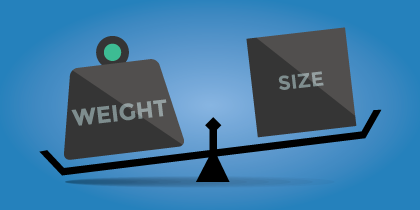
FedEx and UPS have switched to a dimensional pricing program for ground shipments. This new system specifically applies to packages under 3 cubic feet, as both carriers already use dimensional pricing for packages bigger than 3 cubic feet.
Dimensional pricing gives a carrier the option to charge for a package’s weight or for the size of the cube; whichever is in the carrier’s favor. This change in pricing is caused by the growing trend of e-commerce. Many times products shipped from online orders are small and lightweight compared to the box they are shipped in. This causes a carrier’s loads to be less efficient, and in turn, causes a need for yield improvement.
In a recent Supply Chain Digest article, Jerry Hempstead, a long-time executive at DHL and Airborne Express who is now a consultant in the parcel shipping industry, was interviewed about the current dimensional pricing change and what shippers can do about it.
Hempstead says the first thing parcel shippers need to do is estimate the impact of this pricing change and try to negotiate a better rate. If a shipper has a good reputation with their parcel carrier, they may be able to get what is called a “dilution study.” This study includes data on every package and can determine the additional costs a shipper will incur once the pricing changes take effect. Some carriers, however, may be reluctant to give out this information.
If carriers refuse to release this information, the shippers will have to audit all packages going out the door, Hempstead advises, and apply the dim weight formula to see the effect of the new pricing method. Those that ship bigger and lighter packages will be affected the most.
Hempstead says the most important thing is negotiating. Everything in regards to price is entirely between the carrier and shipper, and ultimately up for negotiation. A shipper can ask for a different dim weight divisor, ask for a phased in approach, or ask for a lower minimum charge. There are many possibilities to negotiate the price of shipments less than 3 cubic feet.
If a shipper cannot negotiate a lower price with a carrier, there are still options to save money. One fairly simple method is to re-design the boxes that products are shipped in.
First of all, Hempstead warns to watch out for bulges in the boxes. This affects the laser beams used by carriers to measure dimensions, and could cause incorrect billing. A shipper should be aware of how inches are rounded (9.5 rounds up, 9.49 rounds down). Hempstead notes one shipper he currently works with that saved by switching boxes that were 9.5 inches high to boxes that are 9.49 inches high. A parcel shipper can also invest in new equipment that automatically constructs the smallest box possible based on the dimensions of the product.
The last option for shippers is to use a regional parcel carrier. A large number of parcel shippers are now switching to regional carriers because these smaller companies are not implementing dimensional pricing like FedEx and UPS. Shippers are seeing other benefits from making the switch too. Regional carriers are typically more flexible, nimble, and very familiar with the area they deliver in. This streamlines the shipping process, on top of the reduced cost.
In a recent interview with Supply Chain Brain, Scott Schwarz, national business development manager with LaserShip, discusses the benefits of regional parcel carriers. Schwarz is very optimistic about the current state of regional carriers. He says they can accommodate any business and often do so more effectively and cheaper than the bigger carriers.
Many question the quality of regional carriers and assume that they will just be absorbed by bigger carriers soon, but Schwarz says this is not the case. With the current rise in business they are seeing, he expects regional carriers to continue growing and remain independent. He is also very optimistic about the future. Schwarz thinks the dream of same-day delivery will be realized through regional carriers. Similarly, regional carriers specialize in inefficient e-commerce packages and are well equipped to handle the strains of omni-channel.
There are many options to avoid dimensional pricing from parcel carriers. Switching to regional parcel carriers may be one of the most effective methods. If you would like assistance reducing the costs of shipping, contact a 3PL, such as PLS Logistics, and let them figure out the cheapest way to ship.
